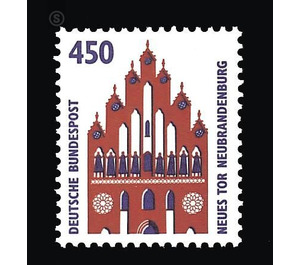Permanent series: sights - Germany / Federal Republic of Germany 1992 - 450 Pfennig
Theme: Architecture
| Country | Germany / Federal Republic of Germany |
| Issue Date | 1992 |
| Face Value | 450.00 |
| Color | brown white |
| Perforation | K 14 |
| Printing Type | indirect 2-color letterpress |
| Stamp Type | Postage stamp |
| Item Type | Stamp |
| Chronological Issue Number | 1496 |
| Chronological Chapter | GER-BRD |
| Michel ID | BRD 1623 |
| SID | 880340 |
| In 57 Wishlists | |
Impressively, a medieval fortification ring surrounds the inner city of Neubrandenburg until today. Although 84% of the historic city was destroyed during the last days of the war in 1945, the city wall with its gates, towers and wharves remained almost intact. The city was founded in 1248 by the Margrave of Brandenburg and fell to Mecklenburg as early as 1300. It built the 2.300 meter long circular stone wall enclosing the circular area of the city, into which up to the 15th century a total of four gateways, two round tower towers and 53 cradle houses were added. Improvements in military technology made constant modernization necessary, especially at the gates, so that today the facilities are mostly in their last, late gothic shaped form. The special jewels of the fortification are the four gates. Far beyond the functional dimension, the gates became a symbol of urban self-confidence and performance through elaborate artistic designs. The latest of the gates is the New Gate, which was inserted in the east of the wall ring in the middle of the 15th century. In his system, it adhered to the proven since the early 14th century scheme with a wall inserted into the course of the tower and a cross-bar-like upstream Vortor, which was connected by side retaining walls with the tower. It was not until after the Middle Ages that the Zingel was added to the New Gate, as it was preserved at Friedländer Tor. Unfortunately, only the gate tower survived from the construction of the New Gate after demolitions in the 19th century. The ground plan rectangular brick building has an arched passage on the ground floor. Spitzbogige window openings and interleaved cloverleaf arch and two richly ornamented rosettes divided on the city side, the walls above. The gable is particularly richly decorated with its eye-catching finishes. But the most striking thing is undoubtedly the eight female figures, wrapped in long white robes, with their arms bent upwards. To this day, it has not been possible to clarify the meaning of these figures, commonly referred to as "virgins". Some want to see angels in them, who with their blessing greet those who leave the city. The same figures can also be found on the city side of the neighboring Stargarder Gate; here they were inserted in an older tower around the middle of the 15th century. During the Middle Ages, the fortification completed its purpose, only in 1631 she was no longer able to cope with the demands of the storm of the imperial troops under Tilly. It had lost its military value since then, and by the middle of the nineteenth century it became virtually superfluous as the city opened up. In the meantime the gates and walls had been accepted as worth seeing and worthy witnesses of medieval architecture and since 1843 their memorial restoration work had been carried out. Such restoration measures have been constantly necessary until today. In addition, one has recently tried to make meaningful use of the buildings that have become inoperative. Recently, a meaningful use has been made of the New Gate: The Fritz Reuter Society, which has recently returned to Neubrandenburg, has recently moved to this location. (Text: State Office for the Preservation of Historic Monuments in Mecklenburg-Vorpommern, Schwerin)
| Condition | Name | In Stock | Price | Price + Shipping | Store | |
|---|---|---|---|---|---|---|
 | Unmounted Mint ** | Permanent series: sights - Germany / Federal Republic of Germany 1992 - 450 Pfennig | 1 | US $4.31 | US $7.53 |  FILATELIELOKET (0) FILATELIELOKET (0)Shipping US $3.22 |


